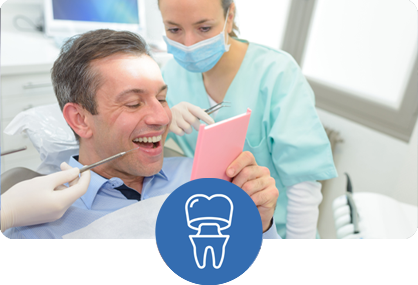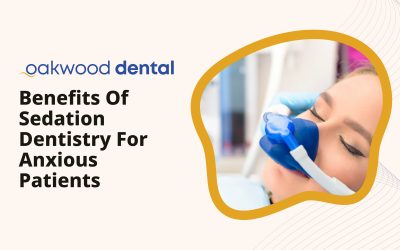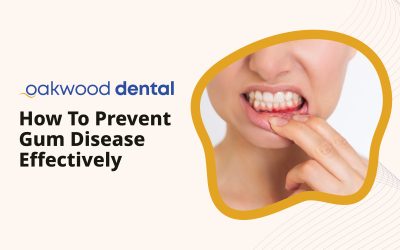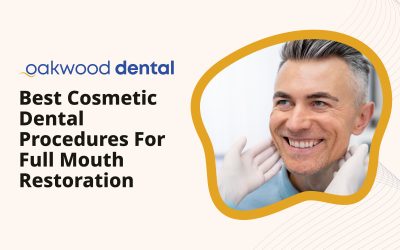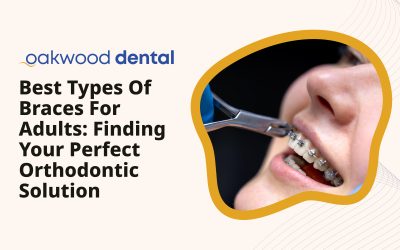Key Takeaways
- Dental crowns protect and reinforce damaged teeth while enhancing their appearance
- Bridges effectively replace missing teeth, preventing shifting and maintaining proper bite alignment
- Both restorations restore functionality for improved eating and speaking
- Modern materials like ceramic and zirconia provide natural-looking results
- CEREC technology allows for same-day crown placement at Oakwood Dental Clinics
- Proper maintenance can extend the lifespan of crowns and bridges for many years
Understanding Dental Crowns and Bridges
Dental restorations help keep your mouth healthy and fix damaged smiles. At Oakwood Dental Clinics, we offer dental crowns and bridges to help patients smile with confidence again. These treatments are important in fixing teeth, making them look good and work properly when you have dental damage or missing teeth.
Dental crowns are like protective caps that cover damaged teeth completely. They wrap around the entire visible part of a tooth above the gumline, making the tooth stronger and stopping more damage. Crowns are made to match your real teeth in shape, size, and color, so they fix both how your teeth work and how they look. Dental bridges fill the gap left by missing teeth by using nearby teeth as supports. These supporting teeth (called abutments) hold the replacement teeth (called pontics) that span the empty space, making your smile complete again.
Both of these options do more than just make your smile prettier. They help you chew and speak better, prevent more dental problems, and improve your overall mouth health. From saving what’s left of a damaged tooth to stopping the problems that come with missing teeth, crowns and bridges are important solutions in modern dentistry that can really improve your life and make you feel better about your smile.
The Protective Power of Dental Crowns
Dental crowns can fix many different dental problems. At Oakwood Dental Clinics, we recommend crowns for teeth that are badly damaged, weak, or don’t look good. These custom-made “caps” completely cover the visible part of the tooth, giving it full protection and support that helps the tooth last much longer. Unlike fillings that only replace part of the damaged tooth, crowns protect the whole tooth from all sides, making them perfect for teeth with lots of damage.
Reinforcing Damaged Teeth
One of the main benefits of dental crowns is how they strengthen teeth weakened by decay, large fillings, or cracks. By covering the entire tooth, a crown gives it support that prevents more damage and helps the tooth last longer. This protection is especially important for teeth that have had root canal treatment, which can make teeth more brittle and likely to break. The crown works like a protective helmet, spreading out biting forces evenly across the tooth and preventing stress that could cause cracks or breaks. For teeth that already have cracks, crowns can stop these cracks from getting worse, often saving teeth that might otherwise need to be pulled.
Restoring Functionality
Damaged teeth often make it hard to chew and speak properly. Dental crowns restore the tooth to its original shape and size, letting patients eat and talk normally again. The strong materials used in modern crowns can handle the forces of biting and chewing, so patients can enjoy their favorite foods without discomfort or fear of damaging their restoration. Well-designed crowns also maintain proper contact with neighboring and opposing teeth, keeping your bite aligned and preventing problems like teeth shifting or jaw pain. Many patients notice right away that they can chew tough or crunchy foods better after getting a crown, which can help their nutrition and digestion by allowing them to properly chew a variety of foods.
Beyond making teeth work better, crowns greatly improve the look of damaged, discolored, or oddly-shaped teeth. At Oakwood Dental Clinics, we offer cosmetic dental solutions including crowns made from tooth-colored materials that blend in perfectly with natural teeth. These improvements can really boost your self-confidence and make you want to smile more. Modern ceramic and porcelain crowns mimic the see-through quality, texture, and light reflection of natural tooth enamel, creating restorations that look just like real teeth. For patients with deep stains that whitening can’t fix, crowns offer a permanent solution for a brighter, more even smile. Even teeth with unusual shapes or developmental problems can be transformed to create a natural-looking smile.
Advanced CEREC Technology for Same-Day Crowns
Traditional crown placement usually requires multiple appointments over several weeks. However, at Oakwood Dental Clinics, we use advanced CEREC technology to provide same-day crown restorations. This amazing approach eliminates the waiting time between preparation and final placement, shrinking what was traditionally a two-to-three-week process into just one convenient appointment. Getting rid of temporary crowns—which sometimes fall off or cause discomfort—is a big improvement in patient experience and treatment efficiency.
CEREC (Chairside Economical Restoration of Esthetic Ceramics) allows our skilled dentists to design, create, and place a custom ceramic crown in just one visit. This revolutionary approach eliminates the need for temporary crowns and multiple appointments, saving our patients valuable time while delivering exceptional results. The digital workflow also reduces the potential for human error that can occur with traditional impression materials and laboratory communication, resulting in restorations with superior fit and function. Additionally, the elimination of conventional impressions—which many patients find uncomfortable—makes the procedure more pleasant for those with sensitive gag reflexes.
The CEREC process involves digital scanning of the prepared tooth, computer-aided design of the restoration, and in-office milling of the crown from a solid block of ceramic material. The result is a precisely fitted, durable, and natural-looking crown that can be placed immediately. This technology represents a significant advancement in cosmetic dentistry, combining convenience with outstanding quality. The high-strength ceramic materials used in CEREC restorations offer excellent durability and aesthetic qualities, with studies showing clinical longevity comparable to or exceeding that of traditional laboratory-fabricated crowns. For busy professionals and patients who value efficiency, CEREC technology provides a perfect solution that doesn’t compromise on quality or appearance.
Bridging the Gap: How Dental Bridges Restore Smiles
Missing teeth cause more than just looks problems; they can lead to many oral health issues including shifting of nearby teeth, bite misalignment, and bone loss. Dental bridges offer a good solution by literally “bridging” the gap left by missing teeth. Unlike removable partial dentures, bridges are fixed in place, giving stability and comfort that feels much like natural teeth. This permanent solution gives patients confidence in their restoration without worrying about movement or slipping that can happen with removable appliances.
Preventing Tooth Movement
When you lose a tooth, the teeth around it naturally start to move toward the empty space. This movement can mess up your bite alignment and cause more dental problems. A dental bridge fills this gap, keeping proper spacing and preventing unwanted tooth movement. Without treatment, teeth next to a gap will gradually tilt into the empty space, while opposing teeth may grow longer looking for contact. These movements can create places where food gets trapped, make cleaning hard, and potentially lead to gum disease or decay in the misaligned teeth. By placing a bridge soon after losing a tooth, these complications can be completely avoided, preserving the health of your entire dental arch and preventing a single missing tooth from causing widespread problems throughout your mouth.
Missing teeth can cause uneven distribution of bite forces, putting too much pressure on the remaining teeth. This imbalance may lead to faster wear, fractures, or more tooth loss. Bridges help distribute these forces more evenly across your dental arch, protecting your natural teeth from too much stress. When teeth are missing, the remaining teeth must handle extra forces during chewing, potentially exceeding what they can handle. This overloading can speed up wear on these teeth, potentially leading to fractures, loosening, or early failure. Dental bridges restore proper force distribution by replacing missing teeth with artificial ones that bear their share of the chewing load. The strategic placement of bridges can optimize bite forces across the entire arch, protecting both the bridge support teeth and other natural teeth from too much strain.
Gaps from missing teeth can affect pronunciation and make certain sounds difficult to say. Additionally, these spaces can make chewing challenging, potentially leading to nutritional problems or digestive issues. Dental bridges restore both speech clarity and chewing efficiency, allowing patients to speak confidently and enjoy a varied diet without limitations. Missing teeth, especially in the front of the mouth, can significantly impact the formation of certain sounds that require tongue-to-tooth contact, such as “t,” “d,” “s,” and “th.” By replacing these teeth with bridges, patients can regain proper speech sounds. Similarly, back teeth are essential for grinding food properly. Their replacement with bridges allows patients to thoroughly chew fibrous vegetables, proteins, and other nutritious foods that might otherwise be avoided, supporting better overall nutrition and digestive health.
Material Options for Crowns and Bridges
The development of dental materials has greatly expanded the options available for crowns and bridges. At Oakwood Dental Clinics, we offer various materials to suit different needs, locations in the mouth, and appearance preferences. Choosing the right material is an important decision that balances factors including strength needs, appearance demands, biocompatibility, and budget considerations. Our experienced dentists will guide you through these options, explaining the advantages and potential limitations of each to help you make an informed decision for your restoration.
Porcelain and ceramic crowns look the most natural, closely matching the see-through quality and color of real teeth. These materials are perfect for front teeth and visible areas of the mouth where looks are most important. Our CEREC system uses high-quality ceramic blocks to create beautiful, long-lasting restorations in a single visit. Modern dental ceramics have improved a lot, with advanced formulations that provide excellent strength while maintaining the optical properties that create lifelike restorations. These materials can be customized with various levels of translucency and multiple color layers to perfectly match surrounding teeth. Additionally, ceramic materials are biocompatible and gentle to surrounding gum tissue, rarely causing the gum discoloration or allergic reactions that can sometimes occur with metal restorations.
Zirconia has become increasingly popular for dental restorations due to its exceptional strength and aesthetic qualities. This material combines the durability of metal with the appearance of porcelain, making it suitable for both front and back teeth. Zirconia crowns and bridges can withstand significant biting forces while maintaining a natural appearance. Often referred to as “ceramic steel,” zirconia is extraordinarily strong, with fracture resistance far exceeding that of traditional ceramics. This makes it particularly valuable for patients with heavy bite forces or grinding habits. Recent advancements in zirconia formulations have improved its optical properties, creating more translucent versions that rival the aesthetics of traditional porcelain while maintaining superior strength. For long-span bridges or patients with limited inter-occlusal space (where a thinner restoration is needed), zirconia provides an ideal combination of strength and aesthetics.
The Crown and Bridge Procedure Process
Understanding what to expect during crown and bridge procedures can help reduce anxiety and prepare patients for their treatment journey. At Oakwood Dental Clinics, we make sure our patients are fully informed about each step of the process. Our open approach to treatment planning helps reduce anxiety and creates realistic expectations about the procedure timeline, sensations during treatment, and expected outcomes. We use advanced techniques and materials to maximize comfort throughout the process, including precise digital planning that minimizes chair time and streamlines the procedure.
Traditional Crown and Bridge Process
- Initial Consultation: Our dentist examines your teeth, discusses treatment options, and develops a personalized plan. This comprehensive assessment may include digital radiographs (X-rays), intraoral photographs, and diagnostic models to evaluate your bite and plan the ideal restoration.
- Tooth Preparation: The affected tooth (for crowns) or abutment teeth (for bridges) are shaped to accommodate the restoration. This involves removing a small amount of enamel. The procedure is performed under local anesthesia to ensure your comfort, and our dentists use precision instruments to conserve as much healthy tooth structure as possible while creating adequate space for a durable restoration.
- Impressions: Detailed impressions are taken to create an exact model of your teeth for fabricating the custom restoration. We use high-quality impression materials that capture microscopic details of your prepared teeth and surrounding structures, ensuring an optimal fit for your final restoration.
- Temporary Restoration: A temporary crown or bridge is placed to protect the prepared teeth while the permanent restoration is being created. These interim restorations maintain tooth position and allow for relatively normal function and appearance during the fabrication period, typically lasting 1-2 weeks.
- Laboratory Fabrication: The impressions are sent to a dental laboratory where skilled technicians craft the permanent restoration. Our office partners with premier dental laboratories that employ master ceramists who meticulously layer materials to create restorations with natural contours, color gradients, and surface characteristics.
- Final Placement: Once completed (typically 1-2 weeks later), the temporary restoration is removed, and the permanent one is carefully checked for fit and appearance before being permanently cemented. We verify proper contacts with adjacent teeth, ensure comfortable occlusion (bite), and confirm that the margins (edges) of the restoration fit precisely against your tooth to prevent decay or sensitivity.
CEREC Same-Day Crown Process
For patients choosing CEREC same-day crowns, the process is streamlined:
First, just like with traditional crowns, the tooth is prepared by removing decay and shaping it. The preparation principles stay the same as traditional methods, but the digital workflow often allows for more conservative preparations. Then, instead of goopy impressions, a digital scanner creates a 3D model of your mouth. This comfortable, powder-free scanning takes just minutes and eliminates the discomfort some patients feel with conventional impression materials. The scanner captures thousands of images per second to create a highly accurate virtual model of your teeth.
Using special software, our dentist designs your crown to exact specifications. The CEREC software allows for precise control over every aspect of the restoration, including thickness, contact points, chewing surface anatomy, and aesthetic details. You can actually watch your restoration being designed on the screen! Next, the design is sent to our in-office milling machine, which carves the crown from a ceramic block. This precision manufacturing typically takes 10-15 minutes and creates a restoration with accuracy measured in microns. Finally, the crown is polished, stained (if needed) to match your natural teeth, and then bonded in place—all in a single appointment.
Long-Term Care and Maintenance of Crowns and Bridges
While dental crowns and bridges are designed to be durable, how long they last depends a lot on proper care and maintenance. With good attention, these restorations can serve you well for many years. Research shows that well-maintained crowns and bridges can last 15 years or more, with many lasting several decades with proper care. The investment in your restoration is best protected through good home care and regular professional maintenance, which helps prevent complications that could harm the supporting teeth or surrounding tissues.
Daily Oral Hygiene
Keeping excellent oral hygiene is crucial for the longevity of your dental restorations. Brush twice daily with a non-abrasive toothpaste and soft-bristled toothbrush. Pay special attention to the area where the crown or bridge meets the gumline, as this junction can collect plaque and bacteria. Daily flossing is essential, particularly around and under bridge pontics, where special floss threaders or interdental brushes may be helpful. For bridges, specialized cleaning tools such as floss threaders, interdental brushes, or water flossers can be invaluable for cleaning underneath the pontic (replacement tooth) and around the abutment teeth. This area is particularly vulnerable to plaque accumulation and requires diligent cleaning to prevent inflammation or decay that could compromise the supporting teeth. Many patients find that adding an antimicrobial mouth rinse to their routine provides additional protection against bacteria that could affect the margins of their restorations.
Regular Dental Check-ups
Schedule regular dental examinations and cleanings at Oakwood Dental Clinics. These appointments allow our team to monitor the condition of your restorations, check for any signs of wear or damage, and address potential issues before they become serious problems. Professional cleanings help remove tartar buildup that can compromise the health of supporting teeth and gums. During these visits, our dentists will evaluate the integrity of your restorations, checking for signs of wear, chips, or margin deterioration that might not be visible or symptomatic to you. Digital radiographs (X-rays) may be taken periodically to assess the health of the tooth underneath a crown or the abutment teeth supporting a bridge. Early detection of issues such as recurrent decay, cement washout, or developing fractures allows for timely intervention that can often extend the life of your restoration and prevent more complex problems.
Avoiding Harmful Habits
- Chewing extremely hard foods or non-food items (ice, pens, fingernails) that can create excessive forces that may chip, crack, or dislodge restorations
- Using teeth as tools to open packages or bottles, which places abnormal stress on teeth and restorations in directions they weren’t designed to withstand
- Grinding or clenching teeth (consider a night guard if you have this habit), as these parafunctional forces can accelerate wear or even cause catastrophic failure of restorations
- Consuming excessive staining substances (coffee, tea, red wine, tobacco) that can discolor the margins of restorations or create color discrepancies between the restoration and natural teeth
Conclusion: Investing in Your Smile with Crowns and Bridges
Dental crowns and bridges are valuable investments in both oral health and quality of life. These restorations offer complete solutions for damaged or missing teeth, providing benefits that go far beyond just looks. When properly planned, placed, and maintained, these restorations can transform both the function and appearance of your smile, often eliminating pain and discomfort while restoring confidence in your appearance and dental function.
At Oakwood Dental Clinics, we know that each patient’s dental needs are unique. Our experienced team is committed to providing personalized care, using the latest techniques and materials to deliver exceptional results. Whether you need a single crown to protect a damaged tooth or a bridge to replace multiple missing teeth, we offer solutions tailored to your specific situation. Our comprehensive approach includes thorough diagnostics, detailed treatment planning, precise clinical execution, and supportive follow-up care to ensure optimal outcomes for every restoration we place.
The benefits of dental crowns and bridges are multifaceted:
- They restore proper function, allowing comfortable eating and clear speech
- They prevent further dental complications by maintaining proper tooth alignment
- They provide aesthetic improvements that boost confidence and social comfort
- With proper care, they offer long-lasting solutions to dental problems
- Modern materials and techniques, including our CEREC same-day crown technology, make the restoration process more convenient than ever
If you’re having dental issues that might benefit from crowns or bridges, we encourage you to contact Oakwood Dental Clinics for a complete evaluation. Our team will assess your situation, discuss your options, and help you make informed decisions about your dental care. We prioritize patient education and clear communication, ensuring you understand the benefits, limitations, and maintenance requirements of any recommended treatment. This teamwork approach leads to treatment decisions that align with your values, goals, and expectations.
Remember, investing in your smile is investing in your overall health and well-being. With proper dental restorations and ongoing care, you can enjoy the confidence and comfort of a beautiful, functional smile for many years to come. The psychological benefits of being able to smile, speak, and eat without embarrassment or discomfort can positively impact every aspect of your life, from professional interactions to personal relationships. By addressing dental problems promptly with appropriate restorations, you’re not just fixing teeth—you’re enhancing your quality of life and preventing more complex and costly problems in the future.

 718-979-2121
718-979-2121
